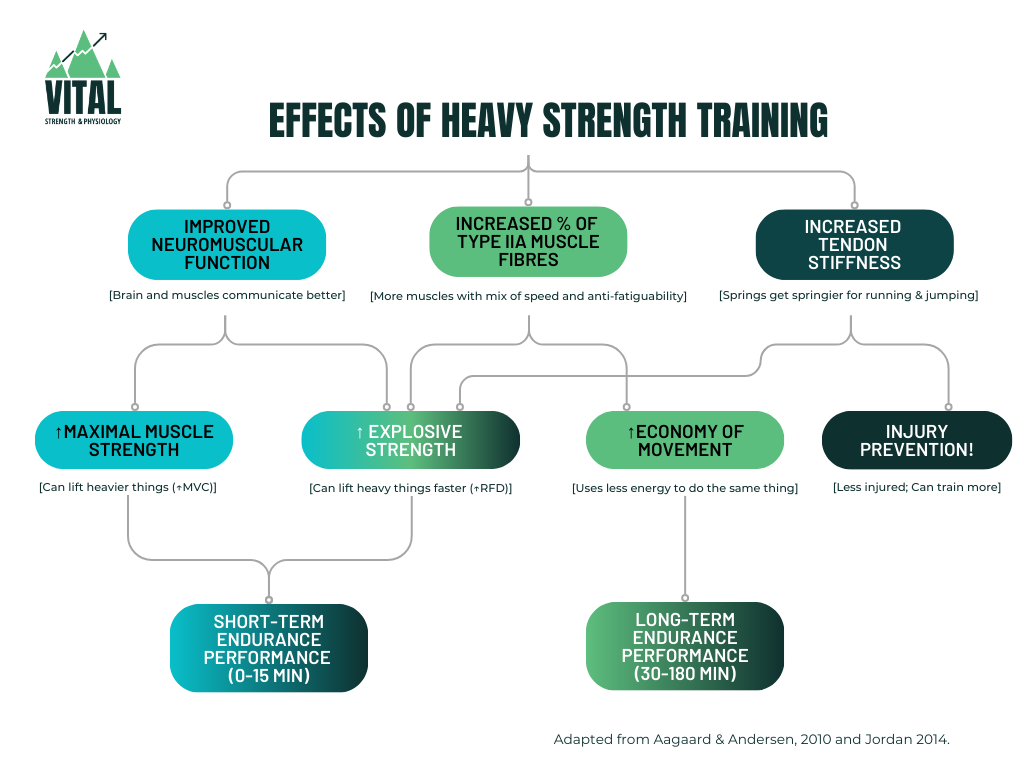Introduction: The Missing Piece of Endurance Training
Strength training is often overlooked in endurance sports, and it’s easy to see why. Endurance sports already demand a huge time commitment. Take an Ironman triathlon, for example: a good finish time for this pinnacle event is around 12 hours, and the training leading up to it often involves 20 to 25 hours of effort per week. High-level running, swimming, and cycling are no different, with massive training volumes required to reach peak performance.
Despite this, strength and endurance don’t have to be in competition—they can actually complement each other to help improve performance.
In this article, we’ll show you why taking even a small portion of your time away from endurance training to incorporate strength work can lead to massive performance improvements. Whether you’re chasing faster times, better endurance, or a more injury-resistant body, strength training might just be the missing piece of your training puzzle.
Why Does Strength Training Improve Endurance Performance?
Improves Muscle Fiber Recruitment
Strength training focuses on developing type II muscle fibres, which are essential for producing high levels of force (Best, 2021; Aagaard & Andersen, 2010). These fibres become stronger and more efficient, enhancing overall muscle force and power. While endurance training mainly targets type I fibres, which are fatigue-resistant but less powerful, building type II fibres gives endurance athletes access to greater power reserves.
It used to be thought that this was particularly beneficial for high-intensity efforts, such as sprinting up hills or finishing strong in a race, but read on to learn why now we know that it’s also beneficial for long-duration endurance events, too.
Enhances Economy of Movement
One of the greatest benefits of strength training for endurance athletes is improved movement economy, which reduces the energy cost of maintaining a steady pace (Best, 2021; Aagaard & Andersen, 2010). For runners, increased musculo-tendon stiffness enhances elastic energy return, acting like free energy with each step.
In cycling and swimming, improved neuromuscular efficiency—the seamless communication between the brain and muscles—reduces wasted energy. This enables trained athletes to sustain higher outputs during long training sessions or competitive events. This benefit is especially important in endurance sports, where Energy conservation helps you during the race and at the finish when you need a boost.
Increases Power and Force Production
Regular resistance training increases maximal force production, allowing athletes to overcome external resistance more effectively, such as headwinds or steep inclines (Best, 2021; Aagaard & Andersen, 2010). Endurance sports often involve prolonged submaximal effort, but greater maximal strength reduces the relative intensity of these efforts, making them feel easier. This combination of strength and power not only boosts endurance performance but also enhances an athlete’s ability to produce force when it matters most.
Improves Fatigue Resistance
Strength training also enhances the oxidative capacity of type II muscle fibres, making them more resistant to fatigue by converting them to their less fatiguable type IIa counterparts (Best, 2021; Aagaard & Andersen, 2010). This adaptation helps delay the need for recruiting our highest-threshold motor units and muscle fibres, allowing endurance athletes to maintain their performance for longer durations. A well-designed strength training program improves fatigue resistance, helping athletes get through tough parts of their endurance sport without losing efficiency or power.
Top Benefits of Strength Training For Endurance Athletes

Improved Endurance Performance in the SHORT and LONG term
Strength training enhances both short and long term endurance performance. Building maximal and explosive strength can improve short-term time trials by up to 50% (Best, 2021; Aagaard & Andersen, 2010). Over the long term, adaptations like increased type IIa muscle fibers and improved tendon stiffness boost movement economy, helping athletes use less energy for the same effort. This can lead to long-term performance improvements of up to 20% for endurance events lasting over 30 minutes.
Injury Prevention
Strength training strengthens connective tissues and improves joint stability, reducing the risk of injuries caused by the repetitive motions of endurance sports. By minimizing wear and tear, athletes can train more consistently, leading to better overall performance and longevity in their sport.
Optimized Muscle Mass Without Bulk
One common concern in endurance sport is gaining too much muscle, but strength training focuses on building strength without the associated size/bulk. Tailored programs help athletes find the right balance of muscle mass and endurance, ensuring optimized performance without compromising efficiency.
How to Incorporate Strength Training into Your Endurance Training Plan
Start by adding 1-2 strength training sessions per week to balance with your endurance training. Focus on exercises that build a strong foundation, like compound lifts (squats and deadlifts), and include sport-specific movements such as single-leg exercises and foot/calf strengthening, which address the high forces experienced during running. Incorporate plyometric and explosive training to improve power, speed, and neuromuscular coordination while enhancing tendon stiffness. Here are a few you can try below:
- Kang Squat (compound exercise)
- Light Tier Swivel Leaps (plyometric exercise)
- Ping Tier Bounds (plyometric exercise)
- Rear Foot Elevated Split Squat (unilateral exercise)
- Bent Knee Calf Raises (lower limb and foot exercise)
- Arch Winding (foot exercise)
Avoid common pitfalls like overtraining or skipping recovery, and progress gradually to avoid injury. Tracking your progress is essential; tools like the TeamBuildr app can help you monitor improvements and stay on track with your strength training program.
Conclusion
Strength training boosts endurance performance, prevents injuries, improves efficiency, and builds functional muscle without bulk. By adding even a small amount to your training plan, you can run faster, recover better, and build a more resilient body.
Explore our Advanced and Pro endurance coaching programs to get a personalized strength plan alongside your endurance plan and elevate your performance today!

More About The Author
Carla Robbins, Owner of Vital Strength and Physiology Inc
Carla’s journey into the world of endurance training, strength and conditioning, and exercise physiology began with her Undergraduate Degree in Exercise Physiology at the University of Calgary and continued into her graduation with a Master’s in Exercise Physiology in 2016. Between working for the Canadian Sports Institute to the creation of her company Vital Strength and Physiology Inc, Carla is driven by a desire to find better ways to address complex cases in professional and everyday athletes and individuals.
References
Aagaard, P., & Andersen, J. L. (2010). Effects of strength training on endurance capacity in top-level endurance athletes. In Scandinavian Journal of Medicine and Science in Sports (Vol. 20, Issue SUPPL. 2, pp. 39–47). https://doi.org/10.1111/j.1600-0838.2010.01197.x
Baar, K. (2006). Training for endurance and strength: Lessons from cell signaling. Medicine and Science in Sports and Exercise, 38(11), 1939–1944. https://doi.org/10.1249/01.mss.0000233799.62153.19
Bell, G., Syrotuik, D., Socha, T., Maclean, I., & Quinney, H. A. (1997). Effect of Strength Training and Concurrent Strength and Endurance Training on Strength, Testosterone, and Cortisol. Journal of Strength and Conditioning Research , 11(1), 57–64.
Best, A. W. (2021). Why does strength training improve endurance performance? American Journal of Human Biology, 33(6). https://doi.org/10.1002/ajhb.23526
Bird, S. P., Tarpenning, K. M., & Marino.1, F. E. (2005). Designing resistance training programmes to enhance fitness: A review of the acute programme. Sports Medicine, 35(10), 841–851.
Gibala, M. J., Little, J. P., van Essen, M., Wilkin, G. P., Burgomaster, K. A., Safdar, A., Raha, S., & Tarnopolsky, M. A. (2006). Short-term sprint interval versus traditional endurance training: Similar initial adaptations in human skeletal muscle and exercise performance. Journal of Physiology, 575(3), 901–911. https://doi.org/10.1113/jphysiol.2006.112094
Hughes, D. C., Ellefsen, S., & Baar, K. (2018). Adaptations to endurance and strength training. In Cold Spring Harbor Perspectives in Medicine (Vol. 8, Issue 6). Cold Spring Harbor Laboratory Press. https://doi.org/10.1101/cshperspect.a029769
Jordan, Matt (2014). Strength and Power Development Course Slides.
Wilson, J. M., Loenneke, J. P., Jo, E., Wilson, G. J., Zourdos, M. C., & Kim, J.-S. (2012). The Effects of Endurance, Strength, and Power Training on Muscle Fiber Type Shifting. Journal of Strength and Conditioning Research, 26(6), 1724–1730. www.nsca-jscr.org



